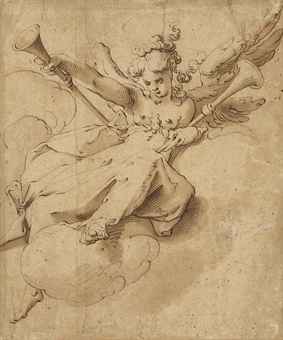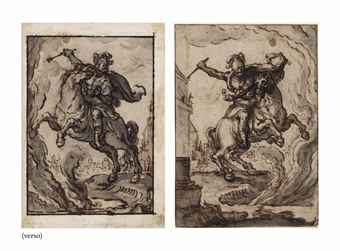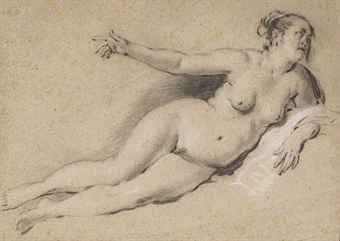 |
| Picture: Christie's |
I've become a bit obsessive about I. Q. van Regteren Altena, a scholar and collector of drawings whose collection is being sold by Christie's. The first part, with drawings by Rembrandt, Rubens, Goltzius and de Gheyn, was sold in London in July, far exceeding estimates. He owned major works by the greatest draughtsmen, but his encyclopaedic collection is most interesting for the drawings by rare and less well known masters. I rather indulgently traveled to Amsterdam for the viewing of the second part, which is being sold tomorrow. The first two auctions are of the Dutch and Flemish drawings that were his specialty. A third sale in Paris will offer his French and Italian drawings, and a final auction in Amsterdam will conclude with yet more Dutch and Flemish drawings.
The dramatic early study by Bloemaert with its bravura foreshortening (above) brings to mind the Spranger drawings that I recently saw on exhibition in New York. I actually prefer this extremely beautiful Bloemaert to many of the Spranger drawings. It's estimated at €15k - €20k. There's also a delightful drawing from Spranger's circle, of the very Sprangerian subject of Jupiter seducing Callisto in the guise of Diana (€2k - 3k).
 |
| Picture: Christie's |
Regteren Altena was a specialist in the de Gheyn family, and this spirited double-sided Marcus Curtius leaping on horseback into the abyss by Jacques de Gheyn II is one of the best things in the sale (€40k - €60k). It's a nice contrast with his beautiful and delicate Portrait of a seated man in an armchair (€25k - €35k). Both of these seem cheaply estimated to me.
There is a gulf between estimates for good but unattributed drawings (or drawings by minor artists) and those by the 'big names', some of which I didn't much care for. And there were plenty of quite minor drawings too, and drawings that can no longer hold the optimistic attributions of yore. The overall the quality is high for such a massive collection, but there are some I don't care for at all. But among the cheaply estimated (perhaps 'teasingly' is the right phrase) lots I liked a red chalk copy of Raphael's The prophets David and Daniel that was long given to Rubens and is now attributed to Erasmus Quellinus. The new attribution is surely not much more than a guess, but it's a striking large drawing related to two of my favourite artists with an estimate of just €1,200 to €1,800. A man holding a rifle attributed to Jacob Martens (€1,500 - €2,000) is another teasingly cheap drawing, a study of a soldier serving as a reminder that the beauty of golden age art was against the backdrop of vicious barbarism of the thirty years' war. A Head of a boy seen in profile is a particularly good unattributed drawing that has been linked to several artists, none convincingly. Estimate of €5k - €8k is high for a drawing without attribution, but reflects its wall power as well as its artistic quality, and I suspect it will do well.
 |
| Picture: Christie's |
Among the group of Rembrandt school drawings is a small Seated man wearing a hat attributed to Arent de Gelder estimated at €2,500 to €3.500. I don't have much confidence in the attribution but I like the drawing at that price. There's a gorgeous Eeckhout A seated girl, seen from behind (€10k - €15k) and an interesting but rather unerotic nude by Flinck (€8k - €12k, above), a fraction the estimate of the more sensual eighteenth century French versions that this seems to prefigure. I actually prefer this Flinck to expensive sugary Bouchers.
Dutch artists obsessively sketched figures and vignettes that found their way into the myriad golden age genre pictures, and some of these studies were among my favourites from this sale, including Lingelbachs and Ostades and one attributed to van der Heyden. I was less taken by the landscapes and nature studies, although a drawing attributed to the exceptionally rare Johan Verwer (€15k - €20k) and a wonderful Dune landscape with gnarled trees by Beresteyn (€25k - €35k) appealed.
It's a big sale, and I haven't even covered all of the highlights. There are rare early drawings including a significant compositional study by van Scorel and an endearing sixteenth century study of a lobster, nineteenth century drawings including a good Ary Scheffer, fabulous sheets by de Bray and Mieris and countless minor masters of the golden age. It was worth the trip; one rarely gets to see such a range of drawings.
Museums were active buyers in the first sale, and I'm sure they will be bidding tomorrow too. It is odd that museums should be so swayed by provenance appeal. The quality of drawings was unquestionably high and there were many extraordinary rarities, but good drawings in general sales are often cheaper. I can think of a few reasons. Christie's gave plenty of notice of the Regteren Altena sales, giving museums time to consider purchases and arrange funds. Trustees and funders can more easily be persuaded of the importance of works from a really significant collection as opposed to those picked out of general sales by curators. There were also plenty of real rarities and unique opportunities in the Regteren Altena sale, although in my view museums sometimes set too much store in filling gaps and pursuing rarities rather than focusing on aesthetic value. And finally curators too are only human; they too can be seduced by the brand power of a great provenance. As a consumer (or wannabe consumer), I'd be willing to pay more for Regteren Altena provenance; I value the link with the great connoisseur. But I don't think museums should be swayed by such romantic nonsense.
That said, there are plenty of drawings that museums should pursue from this collection. The Met should buy the Jordaens copy of their Veronese, the Prado should buy the Teniers study for the painting they own, and Dutch museums should buy some of the drawings of particular historic interest, including the Scorel study for an altarpiece in Breda cathedral. I don't begrudge the museum acquisitions from this great collection, but I wish they would more actively pursue the bargains that often come up at the general drawing sales, too. It was striking that the summer Regteren Altena sale smashed expectations, whereas really good drawings in the mixed owner sales went cheaply or were unsold.
No comments:
Post a Comment